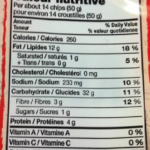I found a graphic to support a learning outcome for one of my ESL lessons on food label reading. Although it is not a very good image, I used it mainly for practice purpose.
Learning Outcome:
At the end of this lesson, students will be able to identify key nutrients on the Nutrition Facts table.
The image has some extraneous details that may present as a distraction, so I cropped it in a way that it shows only the Nutrition Facts Table which is the main focus of the lesson. This way it will enable learners to build a better mental representation of what a standard food label looks like in Canada. (This supports Mayer’s (2014) principle of essential process).
I used a web-based application called Photopea to trim the image. I found the application and the process very easy and straightforward. I believed that this application will be quite useable for me in the future.
I found the graphic in Wikimedia (https://commons.wikimedia.org/wiki/Main_Page. The image was downloaded from Wikimedia page published with a CC BY-SA 4.0 license.

Reference
Mayer, R. E. (2014). Multimedia instruction. In J. M. Spector, M. D. Merrill, J. Elen, & M. J. Bishop (Eds.), Handbook of research on educational communications and technology (4th ed., pp. 385-399). Springer Science & Business Media.
https://doi.org/10.1007/978-1-4614-3185-5

Hi Chwen!
Not sure if this will help you but there are open-resource textbooks for nutrition and they include some nice graphics for reading food labels. Check them out:
https://pressbooks.oer.hawaii.edu/humannutrition2/
https://pressbooks.bccampus.ca/sciencehumannutrition/
Hi Karine,
Thank you for sharing the resource! I will be useful for many of my future projects.
Hi Chwen,
I think a nutrition label is a great way to introduce a key product for informational literacy and to be able to extend conversation and vocabulary around the topic. My kids picked up on these labels when they were young and we were able to extend this to talking about the portion size used for the measurement, and the background levels of things like sodium that they were getting from other foods.